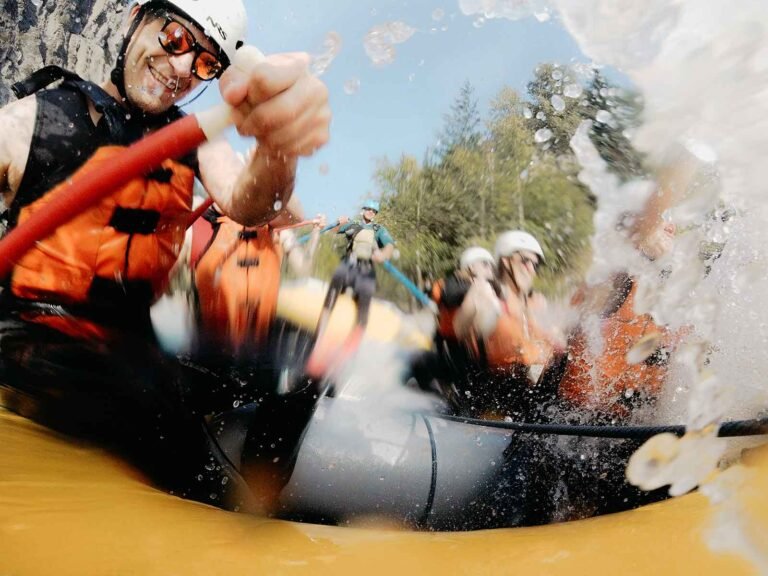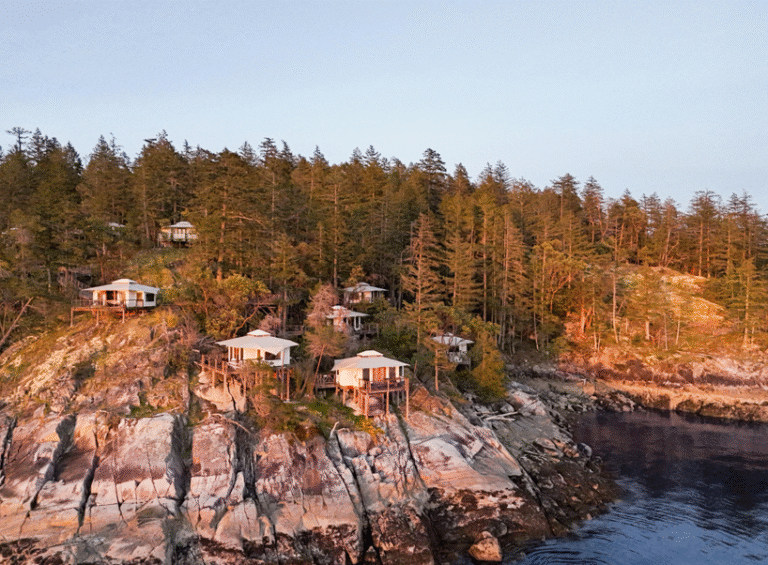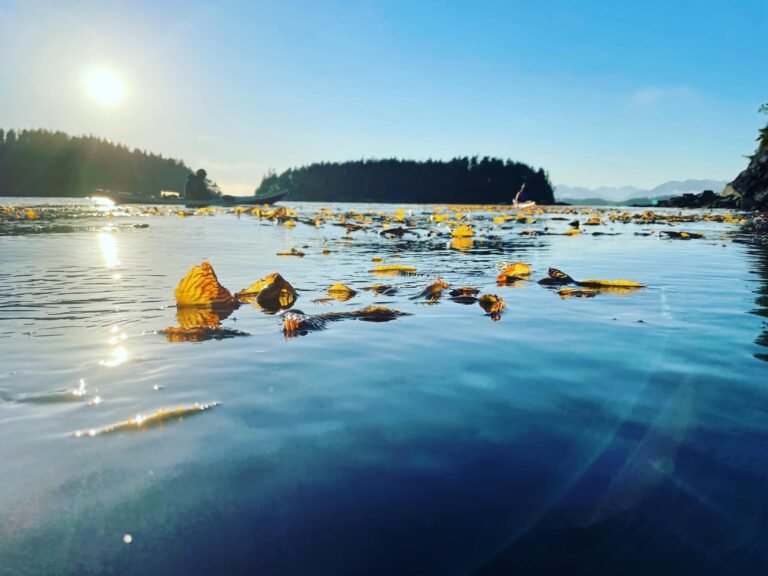There are numerous avid backpackers in northeastern British Columbia, but few marked trails. Bushwhacking is often the order of the day, which suits many people just fine. If you really want to get into the remote areas, contact local backpacking clubs, Forest Service offices, or provincial park offices for detailed information.
For information on hiking in the Prince George region, the Prince George and District Trail Guide provides information on dozens of hikes and walks in the Prince George area.
Some of the more popular destinations include Teapot Mountain, just north of Summit Lake Forest Service Recreation Site, a popular day-trip destination. The trail to the top is short and moderately steep. The trailhead is 3 miles (5 km) west of Hwy 97 on Caine Creek Forest Service Road. Note: There are two other Summit Lakes in northeastern British Columbia, one located near Pine Pass between Prince George and Dawson Creek, and the other situated beside the Alaska Hwy in Stone Mountain Provincial Park.
An esker is a long, narrow, steep-sided ridge of sand and gravel deposited by streams flowing between the icy walls of two glaciers, or through a meltwater tunnel inside a glacier. These glacial features dominate Eskers Provincial Park , a popular day-use area located 25 miles (40 km) northwest of Prince George near Ness Lake. The walking is easy here; the trail to Pine Marsh and Circle Lake is accessible even by wheelchair. There are about 9 miles (15 km) of trails wending their way around the many small lakes in the area. The longest trail runs almost 4 miles (6 km) to the tip of Kathy Lake.
Muskeg Falls Trail lies along 200 Rd, which is about 45 miles (72 km) north of Prince George. It’s about that distance again to the parking lot. An easy walking trail leads to Muskeg Falls in less than an hour. Recently, the 5-mile (8-km) Giscome Portage Heritage Trail was recognized by the provincial government as an important part of British Columbia’s history. The creation of Giscome Portage Regional Park has been proposed to protect the existing trail, which formed a lengthy portage between Summit Lake near Prince George, whose waters flow north and east, eventually ending up in the Arctic Ocean, and the North Fraser River, whose waters flow west to the Pacific Ocean.
Follow in the footsteps of earlier explorers along this trail, which dates back to the turn of the century. You could even carry a canoe on your back if it would help set the mood, though part of the trail is paved over as Hwy 97. The northern trailhead is vaguely located at the junction of Hwy 97 and Barney Rd; the southern terminus, on the banks of the North Fraser River in Hubble Farm Historic Regional Park, east of Hwy 97, is much easier to locate. Interpretive displays on the history of the trail are mounted here each summer.
Crooked River Provincial Park lies 43 miles (70 km) north of Prince George along Hwy 97. There is a pleasant 5.5-mile (9-km) hiking route around Bear Lake and Squaw Lake in the park.
East of Mackenzie is the Morfee Mountain Trail (moderate; 3 miles/5 km return), which leads down from the peak of Morfee Mountain to the headwaters of John Bennett Creek. The trail is short and steep; don’t go down unless you know you can make it back up again. It’s not the usual way to hike a mountain, that’s for sure. The Morfee Mountain Rd goes almost 6,000 feet (1817 m) to the top, though access is restricted to summer. From the top of Morfee, visitors are treated to great views of Williston Lake, the Nechako Plateau, and the Rocky Mountain Trench. Follow Morfee Mountain Road east of Hwy 37 in Mackenzie. The unpaved road begins just north of Morfee Lake.
The Baldy Mountain Trail, an established but unmarked trail near Williston Lake, runs 42 miles (67 km) from Sylvester Creek north to the old gold fields at Manson Creek, with a 2.5-mile (4-km) spur running up to the peak of Baldy Mountain. It’s part of a trail that used to run north from Vanderhoof (on Hwy 16 west of Prince George). It might take a bit of work to find either end, but once you’ve found it, it’s distinct and well maintained by local trapper Oscar Swede. Be prepared for some boggy creek crossings, especially through Sylvester Creek. The trailhead is located west of Williston Lake along a network of Forest Service roads.
North of Mackenzie is Kimta Trail (strenuous; 14 miles/24 km return), which traverses three biogeoclimatic zones and diverse stands of trees to a viewpoint above Kimta Creek. It’s a difficult hike, especially near the top, where the trail passes through dense brush. Expect to take seven to nine hours round trip. The trailhead is located in a Forest Service pullout beside Kimta Creek on the east side of the Parsnip Forest Service Road, about 21 miles (34 km) north of Hwy 37 in Mackenzie.
A steep, 3.1-mile (5-km) trail leads up to Bickford Lookout, a Forest Service fire-spotting tower with exceptional views of the Pine River Valley, just east of the Pine Pass Summit on the north side of Hwy 97, about 30 miles (50 km) west of Chetwynd. About 1.5 miles (3 km) beyond is Bickford Lake. The trail to the lake is unmarked, but follows a mountain ridge almost due north.
Kinuseo Falls are just the tip of the wilderness in large (79,000-acre/32000 ha) Monkman Provincial Park. Day trippers should try hiking from the campground to the Murray River Crossing (moderate; 9 miles/14 km return). Allow at least two days to hike the 15 miles (24 km) to the south end of Monkman Lake. Don’t rush. Monkman is a place of stillness and beauty that should be savoured. From Monkman Lake you can hike into the surrounding mountains. Remember that the southeast corner of Monkman Provincial Park is prime grizzly bear habitat, and though it is not officially closed to visitors, it is recommended that you not head into this area, for the grizzlies’ sake and your own. Extreme caution should be exercised everywhere in the park to prevent confrontations with the bears, and only experienced backpackers should hike beyond Monkman Lake.
Monkman Provincial Park gets all the glory in the Tumbler Ridge area, but there are some excellent hiking trails nearby that are less lauded but equally pleasing. Multi-use trails surround the townsite, perfect for a day of hiking, mountain biking, or cross-country skiing. There is a clearing on the ridge that buttresses Tumbler Ridge’s east side, which looks for all the world like a bald patch. No wonder it’s known locally as the Bald Spot. To reach it, follow a power line that runs up the ridge to the viewpoint. It’s a mighty steep scramble, but the views west over the town and to the Rocky Mountains beyond are worth it.
A little farther from town is the Wapiti Onion Trail. About 7 miles (12 km) west of Monkman Provincial Park as the raven flies lies Onion Lake, a small lake between two mountain ridges of peaks over 6,550 feet (2000 m) high on both sides. You can’t get to it from Monkman (at least, not easily), but you can by following the Wapiti Onion Trail. The trail starts from the Wapiti Forest Service Recreation Site, located about 28 miles (45 km) south of Tumbler Ridge along Hwy 29, then right onto the Wapiti Forest Service Rd for 18 miles (30 km) to a fork. The Forest Service recreation site and trailhead are at the end of the right fork. It’s 7 miles (12 km) from the trailhead to the shores of Wapiti Lake, a popular destination with day hikers.
On the way to the lake, you’ll pass an old cabin and a shrine, built by Father C. Mariman, who lived in this area, translating the bible for the Beaver and Slavey Indians. The trail is well marked, and it’s another 18 miles (30 km) to Onion Lake. Don’t let the first half of the hike fool you; it’s a pretty stiff climb to Onion Lake once you get past Wapiti. Allow two to three days to complete the round trip.
Another multi-use trail runs for 22 miles (35 km) into the backcountry around Red Deer Creek from the Wapiti Onion trailhead and leads to Red Deer Falls. The falls lie 4 miles (7 km) along this lengthy route. Watch out for motorcycles and ATVs on the trail.
For more information on trails around Dawson Creek, including information on popular trails to Mount Bickford, the Paradise Valley Trails, Salt Ridge Trails, and Salt Ridge Connectors, visit the Dawson Creek Visitor Centre.
Chowade River Trail is an unmarked all-purpose trail that hikers should expect to share with off-road vehicles. From Hwy 97, turn west onto 187 Road, just south of the community of Pink Mountain, and drive to the end. For a shorter trip, try the Cypress Creek Trail. Turn left 2 miles (3.5 km) past Halfway River Forest Service Recreation Site on Hwy 97 and drive to the end of the road. It’s possible for active hikers to do the 10.5-mile (17-km) return journey in a day, but you probably should plan on spending the night on the trail.
North of Fort St. John, there are a handful of lengthy, easygoing trails. The longest trail in the area is the Redfern Lake Trail (50 miles/80 km return), which leads to a public cabin at Redfern Lake. The trail is unmarked but easy to follow, and open to ATVs and horses. Expect to take five to seven days there and back. Access to the trail is 3 miles (5 km) north of Buckinghorse River Wayside Provincial Park along Hwy 97.
There are so many truly immense wilderness areas in northern British Columbia that at just over 390,000 acres (158,475 hectares), Kwadacha Wilderness Provincial Park seems modest compared to Spatsizi Plateau, Mount Edziza, or Tweedsmuir Provincial Park. However, this park’s Lloyd George Icefield is the largest icefield in the Rocky Mountains north of the 54th parallel. As the Rockies head towards their northern limit at the 60th parallel (the British Columbia-Yukon border), they begin to diminish somewhat. In Kwadacha, though, they’re still the Rockies: a number of peaks in and surrounding the park crest at 9,100 feet (2800 m).
There is no road access into the park; it must be reached by air or on horseback. It’s about 90 miles (150 km) of backpacking just to make it to the park from Hwy 97, with many treacherous river crossings: allow 12 to 14 days. There are a number of undeveloped trails in the park, and a few primitive campsites. Trails within this park are not maintained, and only experienced wilderness backpackers should venture here. This is beautiful but unforgiving country. Kwadacha Provincial Wilderness Park is located about 100 miles (160 km) southwest of Fort Nelson. For information on charter airplanes and guide outfitters, contact the Fort St. John Chamber of Commerce Visitor Centre, or the Fort Nelson-Liard Regional District Visitor Centre.
Just south of Tetsa River Regional Park on the opposite side of Hwy 97 is the Teetering Rock Hiking Trail, an 8-mile (12.5-km) trail that runs into the escarpments of the Alberta Plateau, providing expansive views of the northern Rockies. The trailhead begins from a viewpoint 10.5 miles (17 km) north of Steamboat Mountain on Hwy 97.
Stone Mountain Provincial Park is 87 miles (140 km) west of Fort Nelson along the Alaska Hwy. Much of the park lies in the alpine tundra biogeoclimatic zone, which means that trees are scarce and mountains of little more than solid rock reach for the sky. The contrast with the rolling, tree-covered foothills farther south is startling. Plan on 7 to 14 days to complete a 44-mile (70-km) loop through the headwaters of Machttps://britishcolumbia.com/wp-content/uploads/2020/07/discovery-islands-lodge-1-accommodation-quadra-island-british-columbia-1.jpg Creek and the adjacent Wokkpash Provincial Recreation Area. Much of the route follows well-trodden game trails laid down by caribou but adhered to by all, as attested to by the wide variety of scat encountered along the way. A horse trail (moderate; 30 miles/50 km return) follows the north side of Machttps://britishcolumbia.com/wp-content/uploads/2020/07/discovery-islands-lodge-1-accommodation-quadra-island-british-columbia-1.jpg Creek from the trailhead at Mile 400 (Km 645) on the Alaska Highway 97.
Old Churchill Mine Road leads into Wokkpash Provincial Recreation Area from One-Fifteen Creek Provincial Park, on Hwy 97. Hoodoos in the Wokkpash Gorge are one of the scenic features at the 7.5-mile (12-km) point along this route. Other highlights in Wokkpash include Forlorn Gorge, an 80-foot (25-m)-wide, 490-foot (150-m)-deep canyon, whose steep-sided slopes should be attempted only with great caution. The nearest help is a long way off in the town of Toad River.
As well as offering tremendous wilderness hiking for the experienced backpacker, Stone Mountain Provincial Park also features several shorter hiking trails more suited to a quick day trip. These include the Summit Peak Trail (strenuous; 6 miles/10 km return) and the Flower Springs Lake Trail (moderate; 7 miles/12 km return), to an alpine lake sublimely situated in the folds of the Stone Mountains. Both trailheads are well marked and begin from pullouts on the east side of Hwy 97.
The 55-mile (90-km) drive through Muncho Lake Provincial Park has a reputation of being the most scenic part of the Alaska Hwy. It’s also one of the most informative. Roadside pullouts appear frequently. Interpretive displays not only provide details on wildlife and geological features but also indicate hiking trails. Accessing higher regions of the Rocky Mountains is easy from here.






